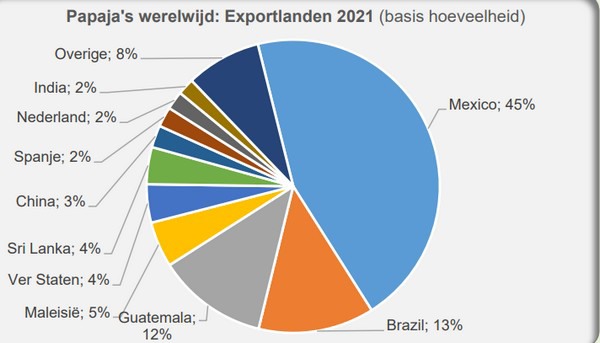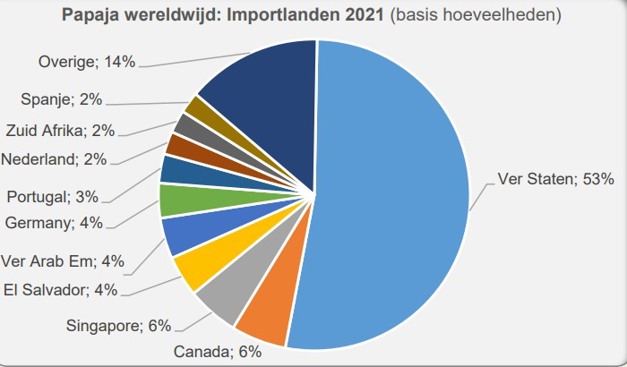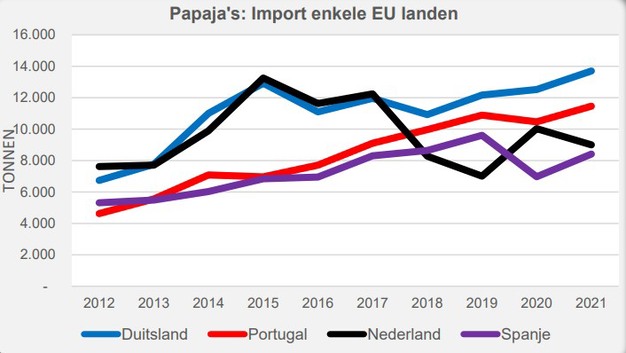Only a few suppliers call the shots on the world's papaya market. While India is by far the leading producer, it exports little. Mexico is the main exporter, with Brazil in second place. Guatemala also exports quite a lot. Malaysia, the United States (most re-exports), Sri Lanka, China, Spain (incl. re-exports), and the Netherlands (re-exports only) follow at a distance.
The big export countries each have their markets with no significant overlaps. Mexico and Guatemala mainly supply the North American market, and Brazil primarily the European one. Most of Malaysia's exports focus on Singapore, Sri Lanka's on the Gulf States, and India's on Nepal and the Gulf States. All principal exporting countries are on the market year-round, and there is no genuine main season.

Decent margins between import and re-export
In total, annually, between 350.000 and 375.000 (net) tons of papaya are traded internationally. That is less than three percent of total global production. In 2021, exports from all countries totaled €280 million. Mexico exported €95 million worth of papayas, and Brazil €43 million. Imports from all countries were considerably higher at €340 million.
Of that, the United States imported €120 million, the same amount as imports from all EU countries put together. In 2021, the Netherlands' imports were worth €13 million, and Belgium's €4 million, with Dutch exports valued at over €20 million. Thus, there was quite a difference in the average (CIF) import price of €2,000 and the (FOB) export price of €3,350 per ton.

Almost all flown in from Brazil
In 2021, the EU (27) countries imported just under 40,000 tons of papayas from non-European Union countries. Of this, 35,000 tons (>90%) came from Brazil. Most Brazilian papayas enter the EU by air, with an increasing proportion arriving in Portugal. In the first nine months of 2022, poorer growing conditions in Brazil brought their exports down by 20% compared to the (record) 2021, and EU imports of Brazilian papaya lagged slightly. Remarkably, however, Portugal imported six percent more papayas from Brazil.
The Netherlands was the main European Union buyer until 2017 when Portugal took over. Last year, though Dutch imports from Brazil fell by 40%, the Netherlands remains the second largest buyer in the EU. Imports of Brazilian products also decreased to Germany, Spain, and France. Italy took more, but (still) in smaller quantities. If the trend of those first nine months continues, 2022's EU imports of Brazilian papayas will amount to about 30,000 tons. That is the smallest quantity since 2016.
Brazil's exports to countries outside the EU fell by 27% too. Brazil depends on EU trade for more than two-thirds of its papaya exports. Only very modest quantities go to North America, a market served by Mexico and Guatemala. Brazil's exports will reach 41,500 tons in 2022, after the previous year's record of more than 50,000 tons.

The United States the top market by far
Besides the European Union, the US is another major papaya sales market. Quantity-wise, it is even much larger; imports into the United States will exceed 200,000 tons in 2022. That is five times as much as imports into the EU. Mexico is by far the US's leading supplier. In 2022, Mexican papaya imports grew slightly and will reach about 165,000 tons.
At 32,000 tons, imports from Guatemala will be almost the same as in 2021. Other suppliers like Dominican Republic, Brazil, Panama, and Belize follow at a distance. The United States' northern neighbor Canada also imports quite a lot of papaya, more than 20,000 tons. Here, too, Mexico is by far the most important supplier.
India large producer but exports very little
There is international papaya trade in (south East) Asia but on a relatively small scale. Although India is by far the largest global producer with a production of more than 6 million tons, they export very little of that. In 2021, India exported 7,200 tons. Previously that had exceeded 10,000 tons. Most of it goes to Nepal. Malaysia exports around 20,000 tons annually. Almost all of that goes to Singapore. Sri Lanka's exports are growing; in 2021 to 16,000 tons. Nearly all of that go to the Gulf states.
Click here for the background figures.
For more information:
Jan Kees Boon
Fruit and Vegetable Facts
Website: www.fruitandvegetablefacts.com
Email: fruitvegfacts@gmail.com
